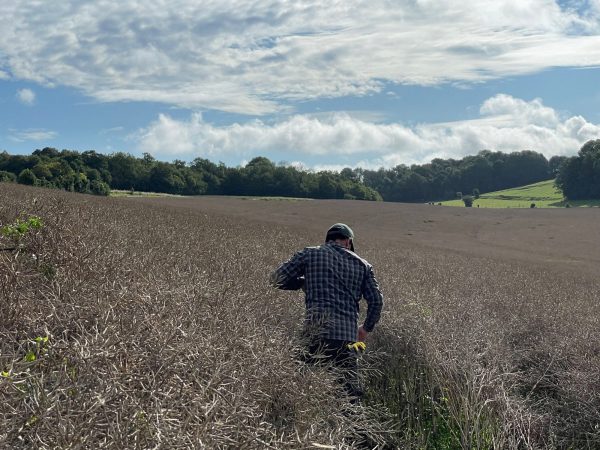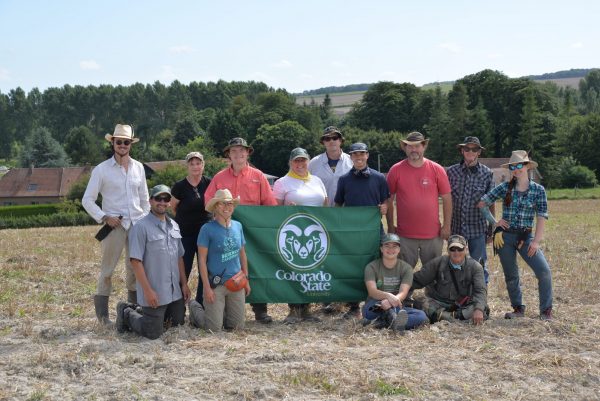CSU center and Anthropology students work to recover remains of American WWII pilot in France
CSU SOURCE | August 23, 2021
Tim Schommer

This year marks the 77th anniversary of the crash of an American bomber in Northern France that occurred in the summer of 1944. The pilot’s remains have gone unrecovered in the European country for decades.
A mission to recover the remains of the pilot who crashed in a farmer’s field is now underway, led by Colorado State University’s Center for Environmental Management of Military Lands in conjunction with the Defense POW/MIA Accounting Agency and archeologists from the Denver Museum of Nature & Science. Together, the team will carry out a veteran’s archaeological excavation in France from mid-August to early September.
“The mission hopes to identify and return the fallen pilot’s remains to American soil,” said Ray Sumner, the mission’s project manager and team leader.
The effort is a follow up to an initial archeological site survey conducted in 2019, which found pieces of wreckage consistent with that of a B-17 aircraft, said Sumner, who is also a retired Army Lieutenant Colonel and Ph.D. candidate in the Department of Anthropology and Geography in CSU’s College of Liberal Arts.
The excavation will also include a team of volunteers comprised of CSU students and alumni, metal detector experts and members of the Veterans of Foreign Wars and American Legion posts in Europe. Other participating CSU Anthropology and Geography students include Robert Kaplan, Anthropology Ph.D candidate, William Kane (ANTHGR ’21), and Riley Limbaugh, Anthropology and History major.
In excavating the pilot’s remains, CEMML, housed in the Warner College of Natural Resources, will continue CSU’s long history of serving the U.S. military throughout the world, said Reymundo “Tony” Chapa, executive director of CEMML and the project’s principal investigator.
“As a combat veteran, I am honored to facilitate the DPAA’s mission by leveraging CEMML’s expertise to bring closure to families who have been waiting so long for information about their lost loved ones,” Chapa said.
A challenging endeavor

The team will build on the site survey work carried out in 2019 by conducting a more extensive metal detecting survey to define the area of the most concentrated wreckage. Once defined, the team will excavate in 4-by-4 meter blocks to recover and screen as much material as they can to search for the cockpit area and ultimately the pilot’s remains.
“This is a challenging project because no one on the team has been to the area to plan, a usual first step in any archaeological project,” Koons said. “For this project, we have had to rely on the maps and information of others and will be figuring it out as we go.”
A commitment to fallen service members
Members of the mission from CSU are carrying out the University’s longstanding commitment to U.S. service members; and there is recognition of the great number of Americans still missing in action whose bodies remain unrecovered. In France alone, an estimated 100 aircraft and 286 airmen are still yet to be found, according to the DPAA’s European and Mediterranean Detachment.
Moreover, more than 81,600 Americans remain missing from WWII, the Korean War, the Vietnam War, the Cold War, and the Gulf Wars and other conflicts according to data from DPAA whose mission is to provide the fullest possible accounting of missing service members with the goal of recovering human remains or material evidence that can contribute to the identification of missing DoD personnel in a scientifically defensible way.
Vice President for Research Alan Rudolph reflected on how CSU’s efforts in the mission serve to further support the troops through research.
“As a veteran-friendly campus where we serve the many people who serve our nation, we are deeply grateful for the opportunity to participate in this important recovery of potential remains from a fallen service member,” Rudolph said.
John Hayes, dean of CSU’s Warner College of Natural Resources, reinforces CSU and CEMML’s commitment to serving its military partners and their families.
“This humanitarian effort reflects CEMML’s deep and enduring commitment in support of DoD’s mission, the U.S. military, and the nation. This project illustrates both the significance of the center’s work and the diversity of CEMML’s projects and activities. The expertise and programs in CEMML encompass the full breadth of environmental and cultural services, from natural resources management and environmental compliance to in-depth cultural resources services, like those engaged in this mission in France.”